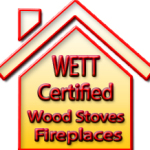Orillia WETT Inspections offers a Certified WETT Inspection of your wood burning appliance whether a Wood Stove, Pellet Stove or Fireplace. With over 10 years of WETT Certified Inspection experience we can help you burn wood safely and more efficiently with valuable tips and advice.
WETT Inspections are based on the Ontario Building Code, CSA and Fire Code. The  requirements of each code have to be examined and compared to installation of your wood burning appliance.
requirements of each code have to be examined and compared to installation of your wood burning appliance.
Areas that are commonly checked for compliance are:
- Chimney
- Liner / Flue
- Smoke Chamber
- Damper
- Firebox
- Hearth / Floor Protection
- Clearance to Combustible Surfaces
When installing chimneys a straight line is always the number one choice, the less bends allows hot gases to freely escape with the better draft created without having elbows installed. Also if your chimney is inside your home and exits out the roof that is also better for chimney. Having the chimney inside your home prevents a lot of heat loss and build up of creosote which occurs when rapid cooling of gases occurs, such as in and exterior mounted chimney.
An unsafe fireplace may have a buildup of creosote. This flammable substance is hard, dark and crust like and is produced during incomplete combustion of wood, and when it accumulates inside the fireplace or chimney over time, it can cause a fire. Active wood burning homeowners are recommended to have their chimney cleaned at least twice every wood burning season. If you only have the occasional fire, and not heating your home with appliance, once a season is considered adequate. Of course if you are burning wet or wood containing a lot of sap, more frequent cleaning maybe required.
Wood Burning Tips
When your wood-burning stove is in use, never leave it unattended, and be sure to follow these safety practices:
- Never use gasoline, lantern fuel, kerosene, charcoal lighter fluid or similar combustible liquids to start a fire.
- Always keep the fireplace damper fully opened when the fireplace is in use.
- Use a grate to hold the logs or fuel load. A grate promotes a uniform fire and prevents logs from rolling out of the firebox.
- When a fire is burning, the fire screen or door should always be in place.
Chimney
The chimney for a wood stove must be masonry or UL-listed, and factory built. Never,  under any circumstances, should an unlined, single brick chimney be used for a wood stove. Single brick chimneys are prone to deterioration, which may allow potentially dangerous situations to develop.
under any circumstances, should an unlined, single brick chimney be used for a wood stove. Single brick chimneys are prone to deterioration, which may allow potentially dangerous situations to develop.
Many older homes have unlined chimneys constructed of double brick. These may be used for a wood stove after carefully checking for cracked mortar or loose or missing brick. Metal sleeves that are listed by the Underwriters Laboratory may be used as chimney lines if they were designed for such use.
Factory built, metal chimneys must never be used with a coal stove, as the corrosive flue gases produced by a coal fire will cause a rapid deterioration of the chimney. Metal chimneys should be completely disassembled after a chimney fire and checked for damage. Discoloration of the exterior indicates a possible breakdown of the insulating material. Any questionable section should be replaced.
A wood burning stove should never be connected to a flue which vents an oil burner. Deadly, unburned vapors from the oil burner could back up into the stove and the room where it is located.
Call Roger for FREE Consultation concerning WETT requirements or installation questions.

Recent Comments